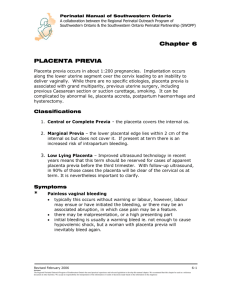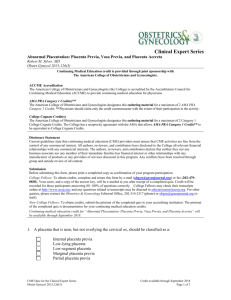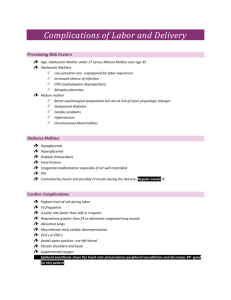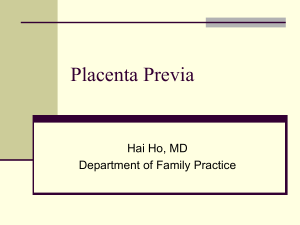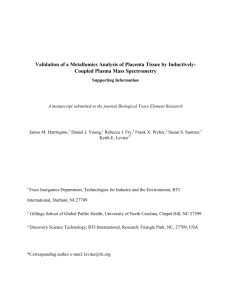AIP Chapter 5 - Antepartum Hemorrhage, 4th Edition
advertisement
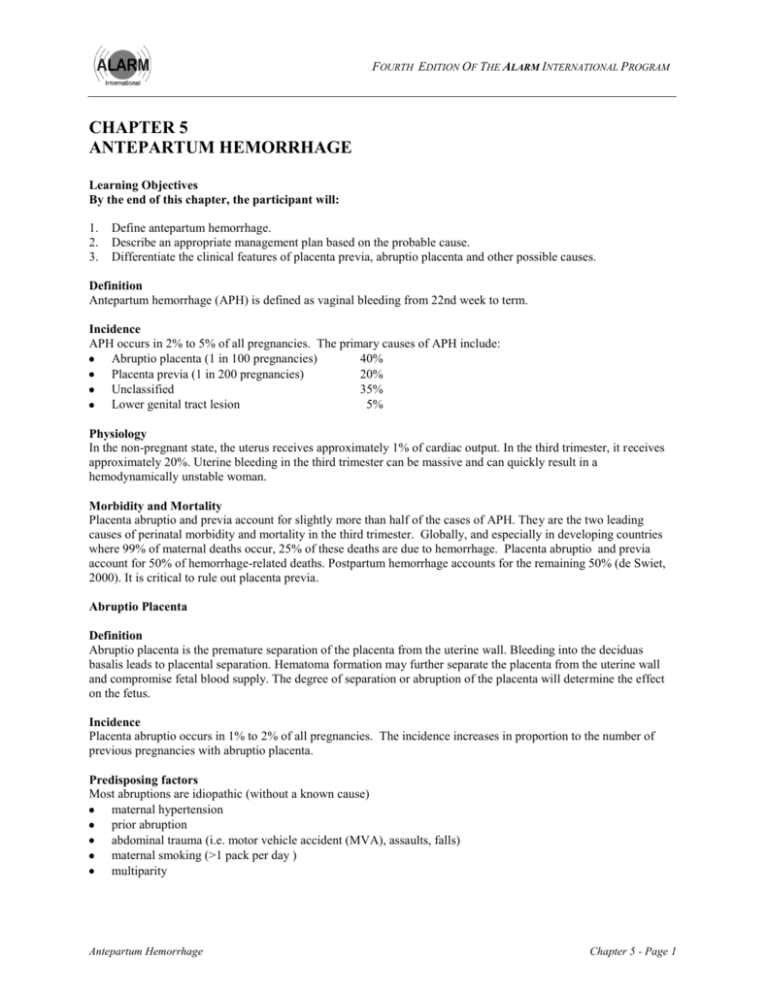
FOURTH EDITION OF THE ALARM INTERNATIONAL PROGRAM CHAPTER 5 ANTEPARTUM HEMORRHAGE Learning Objectives By the end of this chapter, the participant will: 1. 2. 3. Define antepartum hemorrhage. Describe an appropriate management plan based on the probable cause. Differentiate the clinical features of placenta previa, abruptio placenta and other possible causes. Definition Antepartum hemorrhage (APH) is defined as vaginal bleeding from 22nd week to term. Incidence APH occurs in 2% to 5% of all pregnancies. The primary causes of APH include: Abruptio placenta (1 in 100 pregnancies) 40% Placenta previa (1 in 200 pregnancies) 20% Unclassified 35% Lower genital tract lesion 5% Physiology In the non-pregnant state, the uterus receives approximately 1% of cardiac output. In the third trimester, it receives approximately 20%. Uterine bleeding in the third trimester can be massive and can quickly result in a hemodynamically unstable woman. Morbidity and Mortality Placenta abruptio and previa account for slightly more than half of the cases of APH. They are the two leading causes of perinatal morbidity and mortality in the third trimester. Globally, and especially in developing countries where 99% of maternal deaths occur, 25% of these deaths are due to hemorrhage. Placenta abruptio and previa account for 50% of hemorrhage-related deaths. Postpartum hemorrhage accounts for the remaining 50% (de Swiet, 2000). It is critical to rule out placenta previa. Abruptio Placenta Definition Abruptio placenta is the premature separation of the placenta from the uterine wall. Bleeding into the deciduas basalis leads to placental separation. Hematoma formation may further separate the placenta from the uterine wall and compromise fetal blood supply. The degree of separation or abruption of the placenta will determine the effect on the fetus. Incidence Placenta abruptio occurs in 1% to 2% of all pregnancies. The incidence increases in proportion to the number of previous pregnancies with abruptio placenta. Predisposing factors Most abruptions are idiopathic (without a known cause) maternal hypertension prior abruption abdominal trauma (i.e. motor vehicle accident (MVA), assaults, falls) maternal smoking (>1 pack per day ) multiparity Antepartum Hemorrhage Chapter 5 - Page 1 FOURTH EDITION OF THE ALARM INTERNATIONAL PROGRAM advanced maternal age (>35 years) substance abuse (e.g. cocaine and alcohol) uterine malformation short umbilical cord rapid uterine decompression (i.e. premature rupture of membranes (PROM), delivery of the first twin) thrombophilia Classification Classification is based on the extent of separation from the uterine wall (partial vs. complete) and location of separation (i.e. marginal or central) Clinical features of placenta abruptio and placenta previa This chart describes the clinical features associated with placenta abruptio and placenta previa. The information may be used to help differentiate between these two types of APH, and plan care accordingly. Abruptio Placenta Placenta Previa May be associated with hypertensive disorders, uterine overdistension, abdominal trauma Associated with previous uterine surgery, including cesarean section Presenting part may or may not be engaged Head or presenting part is high, or the lie may be unstable Abdominal pain and/or backache (often unremitting) Painless (unless in labour) Uterine tenderness Uterus not tender Increased uterine tone Uterus soft Uterine irritability or contractions No uterine irritability or contractions Usually normal presentation Malpresentation and/or high presenting part Fetal heart may be abnormal or absent Fetal heart usually normal Shock and anemia out of proportion to apparent blood loss Shock and anemia correspond to apparent blood loss May have coagulopathy Coagulopathy very uncommon initially Abruptio may be seen on transabdominal ultrasound, but a negative ultrasound does not rule out abruptio Transvaginal ultrasound is the definitive diagnostic test for placenta previa (see Appendix 1 – Obstetrical Imaging) Chapter 5 - Page 2 Antepartum Hemorrhage FOURTH EDITION OF THE ALARM INTERNATIONAL PROGRAM Placenta Previa Definition Placenta previa is defined as implantation of the placenta in the lower segment of the uterus so that it comes close to or completely covers the internal cervical os. Incidence Incidence of placenta previa is 0.3% to 0.4% of all term pregnancies. Predisposing factors previous cesarean delivery or uterine surgery multiple gestation advanced maternal age multiparity smoking prior placenta previa Classification Figure 1 - Total Placenta Previa Figure 2 - Partial Placenta Previa Figure 3 Marginal Placenta Previa A total (complete) placenta previa describes a placenta that entirely covers the os. A partial previa describes a placenta that partially covers the cervical os. A marginal previa describes a placenta that is lying next to the os. The use of the terms "marginal" and "partial" are meant to apply to digital palpation of the placental edge through the cervix. Vaginal examination should be avoided when there is vaginal bleeding. Both mother and baby could bleed to death if the placenta detaches. Wherever possible, diagnosis of placenta previa is made by ultrasound. Information regarding diagnosis with ultrasound is included at the end of this chapter in Appendix 1. Antepartum Hemorrhage Chapter 5 - Page 3 FOURTH EDITION OF THE ALARM INTERNATIONAL PROGRAM Clinical management In all cases, when placenta previa is suspected, the woman should be transferred to a facility that has cesarean section capability. A policy of expectant management, pioneered by MacAfee, 19 continues to be the standard. The focus on bed rest has been shown to reduce preterm birth and perinatal mortality. 20 However, preterm delivery remains a problem as 46% of women with the diagnosis of placenta previa deliver preterm. 21 Hospital admission with bed rest is an option, but carefully selected women with readily available access to intervention can be managed as outpatients. Almost threequarters of all women with placenta previa experience at least one episode of bleeding at an median gestational age of 29 weeks, but the majority remain stable for a prolonged period and will not deliver until a median of 36 weeks. 22 Clinical outcomes of placenta previa are highly variable and cannot be predicted confidently from antenatal events. 23 A number of retrospective studies provide evidence for the safety and cost-efficiency of outpatient management of placenta previa. 23-26 A randomized control trial of inpatient versus outpatient expected management of placenta previa.suggests that for selected women, outpatient management appears to be an acceptable alternative. This evidence needs to be carefully considered in low-resource settings where access to emergency transportation, blood transfusion services and cesarean section capability may be a factor. Important features to aid diagnosis of placenta previa: Placenta previa is associated with bright red, painless bleeding. Placenta previa is diagnosed primarily by the second trimester ultrasound. Placenta previa is followed over the length of the pregnancy by ultrasound. Placenta previa is present when the leading edge is less than 2 cm from the internal os. Placenta previa usually resolves by term due to placental migration, i.e. as the uterus grows, the placenta moves away from the cervical os. Premature labour and delivery is the primary complication. Some selected women may be followed in an outpatient setting. Transfer to a community or to a facility with adequate resources to manage the woman’s care may be advised. Placenta Accreta Definition Placenta accreta is the abnormal adherence of the placenta with villus attachment to the myometrium. Normally there is tissue called the decidua basalis between the chorionic villi and the myometrium. In placenta accreta these vascular processes grow directly into the myometrium. Placenta accreta can progress into placenta percreta. In placenta percreta, the vascular processes of the chorion (the chorionic villi) may invade the full thickness of the myometrium. The chorionic villi may grow through the myometrium and the outside covering of the uterus (serosa) and result in complete rupture of the uterus. Incidence Placenta accreta should be considered in every woman with placenta previa. The incidence of accreta has increased tenfold in the past 50 years and is now 1 in 2500 pregnancies largely due to the increase in cesarean section deliveries..28, 29 In the presence of placenta previa, the risk of accreta rises to approximately 5%. With placenta previa and prior cesarean section, the risk rises to approximately 20% and increases further with increasing numbers of previous cesarean sections or uterine surgeries.27,29,30 Risk factors Risk factors for placenta accreta include placenta previa with or without previous uterine surgery, prior myomectomy, prior cesarean section, Asherman’s syndrome 1, uterine fibroids and maternal age greater than 35 years.27 1 Asherman's syndrome is a rare condition characterized by the presence of intrauterine adhesions. These adhesions or scars typically occur after uterine surgery, especially after a pregnancy-related dilatation and curettage (D&C). They are more likely to happen if an infection is present in the uterus during the time of the procedure. Intrauterine adhesions can also form after infection with tuberculosis or schistosomiasis. These adhesions may cause amenorrhea and/or infertility. Chapter 5 - Page 4 Antepartum Hemorrhage FOURTH EDITION OF THE ALARM INTERNATIONAL PROGRAM Clinical management It is ideal to diagnose placenta accreta during the antenatal period. Strong clinical suspicion is required in the presence of risk factors. The clinician should aim to rule out an accreta before proceeding to attempting a vaginal delivery. Women with placenta accreta should be delivered in facilities with adequate resources and personnel to manage complications including intrapartum hemorrhage and hysterectomy. Transabdominal and transvaginal ultrasound.31-33 can detect up to 85% of placenta accreta. Further additional investigations using ultrasound Doppler34-37 and magnetic resonance imaging (MRI)38-41 may be helpful to further identify these women, where this technology is available. In most cases, the placenta accreta will be encountered unexpectedly. If the placenta cannot be delivered at the time of cesarean section or following vaginal delivery, one management option is to leave the placenta in situ (in place) without further attempts at delivery if the woman is not actively bleeding. Important considerations related to placenta accreta: 1. The incidence of placenta accreta has increased significantly, mainly due to increased cesarean section surgery rates. 2. Accreta should be suspected in the case of placenta previa, especially if there is a history of prior uterine surgery. 3. Ultrasound and MRI can be used for diagnosis (see Appendix 1 – Obstetrical Imaging). 4. The delivery should be done in a centre with comprehensive emergency obstetric care services to manage complications including intrapartum hemorrhage and hysterectomy. Vasa Previa Definition Vasa previa is the term commonly used when fetal blood vessels in the membranes run across the cervix in front of the presenting part. However, if there are fetal blood vessels in the membranes, they may rupture when the membranes rupture even if not directly in front of the presenting part. When fetal blood vessels are in the membranes they are not protected and are therefore fragile and may easily rupture. Incidence Vasa previa occurs 1 in 5000 pregnancies. Incidence is higher in twin pregnancies. Vasa previa is also associated with a placenta that is low in the uterus, velamentous insertion of the cord and succenturiate lobe. Morbidity and mortality Fetal mortality is estimated to be as high as 50% to 70%. Diagnosis Prenatal diagnosis is unlikely, but may be made by observing fetal vessels crossing the internal os on transvaginal sonography. An attempt to look for such vessels can be made when scanning a woman vaginally for a low placenta. A prenatal diagnosis would mandate closer observation of the woman and delivery prior to term via an elective cesarean section. The clinical diagnosis should be considered when rupture of the membranes is associated with acute painless vaginal bleeding and an abrupt change in the fetal heart rate (tachycardia or bradycardia). Occasionally, the vessels may be felt on digital exam prior to rupture of the membranes. Clinical management When vasa previa is suspected, the baby needs to be delivered quickly. The best course of action will depend on the stage of labour. If the woman is fully dilated, operative delivery with vacuum or forceps is indicated. A cesarean Antepartum Hemorrhage Chapter 5 - Page 5 FOURTH EDITION OF THE ALARM INTERNATIONAL PROGRAM section should be performed if the woman is in labour and not yet fully dilated, if expertise to use vacuum or forceps or the equipment is not available, or in the case of failed operative delivery. The baby is likely to be compromised at birth. Health care providers should be present who are able to resuscitate the baby. The woman and her family should be advised of the gravity of risk to their baby. Where available, an Apt test or Wright’s stain on vaginal blood to detect fetal hemoglobin could suggest the diagnosis. A positive test would indicate that blood is of fetal origin, while a negative test indicates that the blood is of maternal origin. In practice, the Apt test may not be done when there is suspicion of vasa previa, because the time is often very short from onset of bleeding from ruptured blood vessels to fetal collapse from vasa previa. The modified Apt test differentiates fetal from maternal blood. Apt test technique: Collect bloody vaginal fluid. Add a small amount of tap water (hemolyzes blood). Centrifuge or shake the sample. Add 1 cc of 1% sodium hydroxide for every 5 cc of the pink colored fluid (supernatant). Read in 2 minutes.Results: Pink sample = fetal hemoglobin (Hgb) Yellow–brown sample = adult (maternal) Hgb Overview of the Management of Antepartum Hemorrhage If blood loss is significant: Call for HELP from an individual who is culturally appropriate to the community and the family. REMEMBER ABCs (Airway, Breathing, and Circulation) Talk with the woman. Provide information and reassurance. Monitor vital signs (pulse, blood pressure, respiration, temperature). Elevate the woman’s legs to increase return of blood flow to the heart. If possible, raise the foot end of the bed. Urgently mobilize all available health care providers. Turn the woman onto her side to minimize the risk of aspiration if she vomits and to ensure that an airway is open. Keep the woman warm but do not overheat her as this will increase peripheral circulation and reduce blood supply to the vital organs. Take a comprehensive history and perform a physical exam. Clinical differences will give the first clues to the diagnosis. Determine hemodynamic stability. Evaluate uterine tone and activity. Assess the cervix for dilatation or any lesion. Avoid a vaginal exam until placenta previa has been ruled out. Perform an ultrasound, if possible prior to a speculum exam. Controversy exists regarding performing a speculum exam in the absence of a prior ultrasound. Promptly evaluate fetal health. Ask the woman about changes in fetal movement. Auscultate the fetal heart rate or use electronic fetal monitoring where available to determine the health status of the fetus. Ultrasound will assist in assessment of fetal well-being. Chapter 5 - Page 6 Antepartum Hemorrhage FOURTH EDITION OF THE ALARM INTERNATIONAL PROGRAM Carefully monitor the maternal cardiovascular status. Estimate blood loss accurately, taking into consideration the maternal ability to withstand hemorrhage and replace lost fluid volume, as indicated. Where laboratory facilities exist, draw blood for: - Type and crossmatch - CBC, (hemoglobin, hematocrit, platelet count) - PT (prothrombin time) or INR (International Normalized Ratio), PTT (partial thromboplastin time), fibrinogen level - A Kleihauer-Betke test2 may confirm an abruption and is advisable in all cases of suspected abruption. Arrange for blood donors, if needed. Where available, Rh immune globulin should be given to all unsensitized Rh-negative women with any bleeding or suspected concealed abruption. The dose may be adjusted by the Kleihauer-Betke results. The usual dose is 300 µg of Rh immune globulin should be given for every 30 cc of fetal blood detected in maternal circulation (equivalent to 15 cc of packed red blood cells). Unstable woman The two immediate objectives for women who are actively bleeding and hemodynamically unstable are fluid replacement and delivery. While speeding up delivery or preparing the woman for transfer, the following management steps should occur at the same time. Administer oxygen to all women who are hypotensive because oxygen consumption is increased 20% in pregnancy and the fetus is sensitive to hypoxia. Monitor maternal oxygen saturation, where possible. Begin active fluid resuscitation and/or blood transfusion using two large bore (16-gauge or largest available) intravenous lines. Rapidly infuse intravenous fluids (normal saline or Ringer’s lactate) initially at the rate of 1 L in 15–20 minutes; give at least 2 L of these fluids in the first hour. This is over and above fluid replacement for ongoing losses. Aim to replace 2–3 times the estimated fluid loss. Perform an ongoing assessment of maternal vital signs, including urine output) Continuously monitor fetal well-being. If blood transfusion and cesarean section facilities do not exist, the woman should be stabilized, if possible, and then transferred to an appropriate facility. A cesarean section is required if bleeding is due to a placenta previa (partial or complete) or abruption when maternal or fetal health is unstable, unless vaginal delivery is imminent. If the cervix is dilated, operative vaginal delivery may be an option in cases of placenta abruptio. Disseminated intravascular coagulopathy (DIC) should be considered. The “bedside clot test” may be helpful. Assessing clotting status is useful in determining if coagulopathy is present. Bedside clot test Take 2 mL of venous blood into a small, dry, clean, plain glass test tube (approximately 10 mm x 75 mm). Hold the tube in your closed fist to keep it warm (+37 °C). After 4 minutes, tip the tube slowly to see if a clot is forming. Then tip it again every minute until the blood clots and the tube can be turned upside down. Failure of a clot to form after 7 minutes or a soft clot that breaks down easily suggests coagulopathy. 2 The Kleihauer-Betke ("KB") test, Kleihauer test, is a blood test used to measure the amount of fetal hemoglobin transferred from a fetus to an Rh-negative mother's bloodstream. It is the standard method of detecting fetal–maternal hemorrhage. Antepartum Hemorrhage Chapter 5 - Page 7 FOURTH EDITION OF THE ALARM INTERNATIONAL PROGRAM If coagulopathy is present: Correct with fresh frozen plasma or cryoprecipitate, where available. Attempt to deliver as soon as clotting factors have been corrected and volume replacement is adequate. The risk of DIC is increased if the woman presents with an intrauterine fetal death. Once maternal and fetal statuses are stable, consider transfer to a high-risk centre if necessary. Stable woman Continue maternal and fetal surveillance for 12 to 24 hours. Appropriate attention should be paid to the maternal hemodynamic status. All women with an APH are at risk for recurrent bleeding. If the woman has suffered abdominal trauma and is 20 weeks gestation, it is recommended that she be monitored for a minimum of 4 hours after the trauma. If there are ominous signs such as bleeding, uterine pain, or more than one contraction in 10 minutes, the duration of surveillance should be longer because abruptio placenta is seen in about 20 % of such cases. If the fetus is preterm, expectant management may be appropriate depending on maternal fetal status. Antepartum steroids are indicated for a gestational age of 24 to 34 weeks. Consider the risk on significant subsequent bleeding against fetal maturity. Transfer to a high-risk centre may be indicated, based on the maternal and fetal status, and local resources. There is insufficient information to recommend use of tocolytics. Conclusion A standard protocol for the management of APH is essential. A sample protocol is located at the end of this chapter in Appendix 2 A medical or midwifery directive for nursing staff to initiate management is recommended. The lifethreatening nature of abruptio placenta and placenta previa for both mother and fetus should be kept in mind, as should the potential for rapid evolution of these conditions. Vigorous resuscitation should be undertaken when appropriate. Ultrasound determination of placental location should precede vaginal examination, if it is available. Ongoing surveillance and active management are required. Key Messages 1. 2. 3. APH is most commonly due to placental abruption and placenta previa. The primary clinical difference is the experience of abdominal pain by the woman. Rapid diagnosis and prompt, appropriate treatment is critical to prevent infant and maternal mortality. Treatment for this emergency is at the hospital level; therefore, an efficient referral system is needed. Suggestion for Applying the Sexual and Reproductive Rights Approach to this Chapter The lack of available blood when it is necessary for a transfusion following a hemorrhage is a major concern. In some areas of the world, there is a fear among people about giving blood. Communities need to be educated about and sensitized to the fact that giving blood is safe and that it can save a woman’s life. Prepare women and their communities about the possible need for a blood transfusion in pregnancy, during labour and birth or in the postpartum period. Education about blood donation should include how blood is taken, how blood is tested, how confidentiality is maintained and how the body continues to function when a small amount of blood is taken from a healthy person. Chapter 5 - Page 8 Antepartum Hemorrhage FOURTH EDITION OF THE ALARM INTERNATIONAL PROGRAM APPENDIX 1 OBSTETRICAL IMAGING The advent of ultrasound has dramatically changed the clinician’s approach to placenta previa. Ultrasound is a tool that can be used to define clearly the distance of the leading edge of the placenta from the internal cervical os. Placenta previa is defined as implantation of the leading edge placenta less than 2 cm from the internal cervical os. Transabdominal Sonography Transabdominal sonography (TAS) in the second trimester will detect over 85% of placenta previa. TAS evaluation of a placenta previa can be limited for several reasons including poor visualization of the posterior placenta 4 caused by the fetal head interfering with the visualization of the lower segment, 5 obesity and under filling or overfilling of the bladder.6,7 For these reasons, TAS is associated with a false positive rate of up to 25% for the diagnosis of placenta previa. 8 Transvaginal Sonography Transvaginal sonography (TVS) is considered to be safe and is the gold standard for diagnosis,9 with a diagnostic accuracy rate of 99%.10 Accuracy rates for TVS are high (sensitivity 87.5%, specificity 98.8%, positive predictive value 93.3%, negative predictive value 97.6%). In the case of previa with active bleeding, the clinician must proceed with caution, although TVS has been used safely in the presence of placenta previa.11,12 Using TVS, the internal os is seen as a discrete point and the distance from this point to the leading edge of the placenta can be accurately measured. This should be done in situations when the placenta is situated low in the uterus and the distance from the os cannot be clearly seen transabdominally. A placenta that does not reach the os on an 18–20 week scan is not a placenta previa. When a placenta previa is suspected on a transabdominal ultrasound, a follow up ultrasound in the third trimester (28–32 weeks) is indicated. After 26 weeks gestation When the leading edge of the placenta is 2 cm or less from the internal os as measured by transvaginal ultrasound, there is greater likelihood of a clinical picture consistent with placenta previa. After 35 weeks gestation Most cases with any degree of overlap (true previa) will require cesarean section. For those women without overlap: Distance of placental edge from the os (cm) 0–1 1–2 more than 2 cm Estimated probability of safe vaginal delivery up to 15% up to 40% the placenta should not be considered as low lying, expect a safe vaginal delivery With placenta previa and previous uterine surgery, management would ideally occur in a centre with adequate resources to manage potential complications. Placenta accreta should be considered in any woman with placenta previa. The incidence of accreta is 1 in 2500 pregnancies. In the presence of placenta previa, the risk rises to approximately 5%. With placenta previa and prior cesarean section, the risk rises to approximately 20% and increases further with increasing numbers of previous cesarean sections or uterine surgeries (Miller et al, 1997). Clinical Management The role of the clinician is to manage placenta previa when it is visualized on the second trimester ultrasound. If the leading edge is not well seen with TAS, then TVS can be used safely to verify the edge of the placenta and to measure accurately the distance from the internal os. Antepartum Hemorrhage Chapter 5 - Page 9 FOURTH EDITION OF THE ALARM INTERNATIONAL PROGRAM Placental “migration” involves the leading edge of the placenta moving away from the cervical os and continuing into the late third trimester.7,13,14 This is due to the differential growth of the lower uterine segment. The lower segment of the uterus continues to grow in the third trimester. 7,13,14 The time point of the gestation when previa is diagnosed is critical because this will influence management. At 17 weeks gestation, 5% to 15% of women will have placental tissue covering the os, although 90% will have resolved by term.15 Prospective studies have demonstrated that using second trimester ultrasound scans followed by a repeat scan after 35 weeks gestation can assist the clinician in predicting the likelihood of a vaginal delivery. 16,17 Chapter 5 - Page 10 Antepartum Hemorrhage FOURTH EDITION OF THE ALARM INTERNATIONAL PROGRAM APPENDIX 2 Antepartum Hemorrhage Chapter 5 - Page 11 FOURTH EDITION OF THE ALARM INTERNATIONAL PROGRAM Resources: Baskett TF. Essential Management of Obstetric Emergencies. Bristol: Clinical Press Ltd; 4th Edition. 2004. Benson MD. Obstetrical Pearls. Chicago: FA Davis Company; 1994:177–184. King DL. Placental migration demonstrated by ultrasonography. A hypothesis of dynamic placentation. Radiology. 1973 Oct;109(1):167–70. Rasmussen S, et al. The Effect on the Likelihood of Further Pregnancy of Placenta Abruption and the Rate of Reoccurrence. Br J Obstet Gynaecol 1997;104:1292–5. Sexton M. The 5-Minute Clinical Consult. Baltimore: Williams and Wilkins; 1995:4-5:800–1. Chapter 5 - Page 12 Antepartum Hemorrhage
